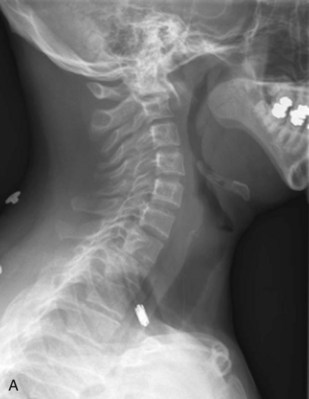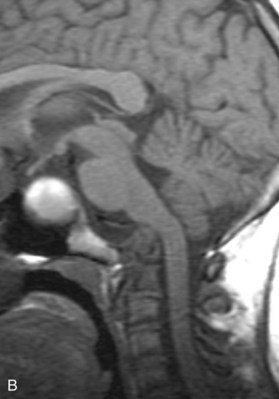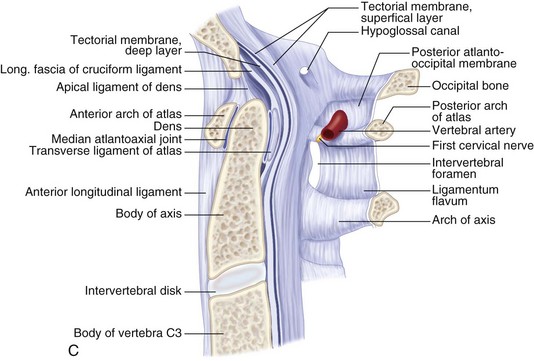Procedure 3 Anterior Odontoid Resection
The Transoral Approach
Indications
 Generally, for the correction of irreducible, ventral compression of the cervicomedullary junction.
Generally, for the correction of irreducible, ventral compression of the cervicomedullary junction.
 Specifically, for ventral extradural, midline pathology from the lower clivus to the C2-3 disk. Anticipated dissection should not extend laterally more than 11 mm on either side of the midline, as this may result in damage to the eustachian tubes, hypoglossal nerves, or vertebral arteries.
Specifically, for ventral extradural, midline pathology from the lower clivus to the C2-3 disk. Anticipated dissection should not extend laterally more than 11 mm on either side of the midline, as this may result in damage to the eustachian tubes, hypoglossal nerves, or vertebral arteries.
 Commonly used to decompress neural elements, typically in patients with rheumatoid arthritis. Cervicomedullary neural compression may be due to
Commonly used to decompress neural elements, typically in patients with rheumatoid arthritis. Cervicomedullary neural compression may be due to
 As part of a staged procedure, may be used to excise a chordoma or other midline extradural tumor at the craniocervical junction
As part of a staged procedure, may be used to excise a chordoma or other midline extradural tumor at the craniocervical junction
 May very occasionally be used for midline intradural pathology, such as meningiomas and schwannomas, usually as part of a staged procedure.
May very occasionally be used for midline intradural pathology, such as meningiomas and schwannomas, usually as part of a staged procedure.
Examination/Imaging
 Neurologic and musculoskeletal examination
Neurologic and musculoskeletal examination
 Preoperative imaging should include multiplanar radiographs of the cervical spine, computed tomography (CT) with sagittal and coronal reformatting, and magnetic resonance imaging (MRI) to clearly define any soft tissue pathology and the degree of neural compression (Figure 3-1).
Preoperative imaging should include multiplanar radiographs of the cervical spine, computed tomography (CT) with sagittal and coronal reformatting, and magnetic resonance imaging (MRI) to clearly define any soft tissue pathology and the degree of neural compression (Figure 3-1).
 CT reformatted images provide detailed information about the bony elements and can be beneficial in planning posterior instrumentation procedures.
CT reformatted images provide detailed information about the bony elements and can be beneficial in planning posterior instrumentation procedures.
 Image guidance has been used as an adjunct for anterior odontoid resection, including frameless stereotaxy and intraoperative MRI. However, frameless stereotaxy may be inaccurate because of the mobility of the craniocervical junction.
Image guidance has been used as an adjunct for anterior odontoid resection, including frameless stereotaxy and intraoperative MRI. However, frameless stereotaxy may be inaccurate because of the mobility of the craniocervical junction.
 Magnetic resonance angiography (MRA) may be beneficial in defining the vascular anatomy and relationship of the vertebral arteries to the midline, as well as dominance of one vessel.
Magnetic resonance angiography (MRA) may be beneficial in defining the vascular anatomy and relationship of the vertebral arteries to the midline, as well as dominance of one vessel.
 In the treatment of patients with rheumatoid arthritis, it is suggested that anti-tumor necrosis factor be held 2 to 4 weeks before surgery and up to 2 weeks after. There is no definitive evidence to suggest methotrexate should be discontinued perioperatively.
In the treatment of patients with rheumatoid arthritis, it is suggested that anti-tumor necrosis factor be held 2 to 4 weeks before surgery and up to 2 weeks after. There is no definitive evidence to suggest methotrexate should be discontinued perioperatively.
Treatment Options
• Anterior odontoid resection through the transoral approach (transoral-transpharyngeal, with or without palatotomy)
• Combined anterior odontoid resection through the transoral approach, followed by posterior stabilization with possible decompression
• Standalone posterior stabilization with possible decompression
• Adjunctive traction reduction (in setting of reducible basilar invagination or atlantoaxial subluxation), followed by posterior stabilization
Surgical Anatomy
 Understanding the ligaments of the craniovertebral junction is vital when operating in this region.
Understanding the ligaments of the craniovertebral junction is vital when operating in this region.
 The atlas is united to the occipital bone by the anterior and posterior atlanto-occipital membranes.
The atlas is united to the occipital bone by the anterior and posterior atlanto-occipital membranes.
 The atlantoaxial joint consists of four articulations and two key ligaments. Two synovial joints for each lateral mass and two odontoid joints, on the anterior and posterior aspects.
The atlantoaxial joint consists of four articulations and two key ligaments. Two synovial joints for each lateral mass and two odontoid joints, on the anterior and posterior aspects.
 The alar ligament arises laterally from the odontoid to attach to the occipital condyles. The apical ligament runs from the odontoid process to the anterior margin of the foramen magnum. Disruption of any of the aforementioned ligamentous structures runs an increased risk for basilar invagination.
The alar ligament arises laterally from the odontoid to attach to the occipital condyles. The apical ligament runs from the odontoid process to the anterior margin of the foramen magnum. Disruption of any of the aforementioned ligamentous structures runs an increased risk for basilar invagination.
 The cruciate ligament runs from the atlas to the axis anteriorly. Atlantoaxial dissociation results from damage to this ligament, requiring surgical intervention.
The cruciate ligament runs from the atlas to the axis anteriorly. Atlantoaxial dissociation results from damage to this ligament, requiring surgical intervention.
 Below the foramen magnum, the oropharynx is separated from the prevertebral fascia by a well-defined areolar plane (Figure 3-2). The oropharyngeal mucosa heals remarkably well after surgical incision and repair.
Below the foramen magnum, the oropharynx is separated from the prevertebral fascia by a well-defined areolar plane (Figure 3-2). The oropharyngeal mucosa heals remarkably well after surgical incision and repair.
 The most important bony anatomic landmarks for the transoral approach are the midline structures: rostrally, the septal attachment to the sphenoid, the pharyngeal tubercle on the clivus; and caudally, the anterior tubercle of the C1 arch. The longus colli muscles flank the dens on each side and, more laterally, the longus capitis muscles.
The most important bony anatomic landmarks for the transoral approach are the midline structures: rostrally, the septal attachment to the sphenoid, the pharyngeal tubercle on the clivus; and caudally, the anterior tubercle of the C1 arch. The longus colli muscles flank the dens on each side and, more laterally, the longus capitis muscles.
 The anterior longitudinal ligament extends caudally in the midline.
The anterior longitudinal ligament extends caudally in the midline.
Positioning
 Neurophysiologic monitoring electrodes for somatosensory-evoked potential and transcranial motor-evoked potential monitoring are placed first.
Neurophysiologic monitoring electrodes for somatosensory-evoked potential and transcranial motor-evoked potential monitoring are placed first.
 Fiberoptic nasotracheal intubation is then performed.
Fiberoptic nasotracheal intubation is then performed.
 A nasogastric tube should also be placed for intraoperative gastric drainage and postoperative feeding.
A nasogastric tube should also be placed for intraoperative gastric drainage and postoperative feeding.
 The patient’s head can be fixed in a three-pin fixation system with slight extension. Alternatively, a horseshoe with Gardner-Wells traction or the head resting on a circular headrest can be used.
The patient’s head can be fixed in a three-pin fixation system with slight extension. Alternatively, a horseshoe with Gardner-Wells traction or the head resting on a circular headrest can be used.
 Extension should not be used in patients with fixed cervical kyphosis. Rather, they should be placed in slight Trendelenburg position to assist in the rostral extent of the dissection. One caveat to this would be the limitations in positioning caused by cervical instability or cervicomedullary compression; in this case, positioning is done cautiously with neuromonitoring.
Extension should not be used in patients with fixed cervical kyphosis. Rather, they should be placed in slight Trendelenburg position to assist in the rostral extent of the dissection. One caveat to this would be the limitations in positioning caused by cervical instability or cervicomedullary compression; in this case, positioning is done cautiously with neuromonitoring.
Positioning Pearls
• Because many patients have inherent spinal instability, perisurgical neck immobilization may be required. Halo immobilization, however, will limit neck extension and surgical exposure.
• The placement of topical 1% hydrocortisone on the oral mucosa, before and after surgery, may reduce the incidence of lip and tongue swelling.
Positioning Pitfalls
• Inability to widely open the mouth is a relative contraindication to this procedure. As a general rule, in the adult population, if you cannot place three fingers into the mouth of a patient with his or her mouth fully opened, the transoral approach should be avoided. Otherwise, splitting the mandible and tongue may be needed for adequate exposure.








